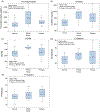Thrombosis risk factors in PIK3CA-related overgrowth spectrum and Proteus syndrome
- PMID: 31490637
- PMCID: PMC8513083
- DOI: 10.1002/ajmg.c.31735
Thrombosis risk factors in PIK3CA-related overgrowth spectrum and Proteus syndrome
Abstract
Increased risk of thromboembolism has been recognized in individuals with mosaic overgrowth disorders, Proteus syndrome (PS) and PIK3CA-related overgrowth spectrum (PROS), including Klippel-Trenaunay syndrome and CLOVES syndrome. PS and PROS have distinct, yet overlapping clinical findings and are caused by somatic pathogenic variants in the PI3K/AKT gene signaling pathway. PS is caused by a single somatic activating AKT1 c.49G > A p.E17K variant while PROS can be caused one of multiple variants in PIK3CA. The role of prothrombotic factors, endothelial cell adhesion molecules, and vascular malformations in both PS and PROS have not been previously investigated. A pilot study of prospective clinical and laboratory evaluations with the purposes of identifying potential risk factors for thrombosis was conducted. Doppler ultrasounds and magnetic resonance angiogram/ venography (MRA/MRV) scans identified vascular malformations in PS and PROS that were not appreciated on physical examination. Abnormal D-dimers (0.60-2.0 mcg/ml) occurred in half of individuals, many having vascular malformations, but no thromboses. Soluble vascular endothelial markers, including thrombomodulin, soluble vascular adhesion molecule (sVCAM), soluble intercellular adhesion molecule (sICAM), E-selectin, and P-selectin were significantly higher in PS and PROS compared to controls. However, no single attribute was identified that explained the risk of thrombosis. Predisposition to thrombosis is likely multifactorial with risk factors including chronic stasis within vascular malformations, stasis from impaired mobility (e.g., following surgery), decreased anticoagulant proteins, and effects of AKT1 and PIK3CA variants on vascular endothelium. Based on our findings, we propose clinical recommendations for surveillance of thrombosis in PS and PROS.
Keywords: PIK3CA-related overgrowth spectrum (PROS); Proteus syndrome; deep vein thrombosis (DVT); pulmonary embolism (PE); thrombosis.
Published 2019. This article is a U.S. Government work and is in the public domain in the USA.
Figures




Similar articles
-
Characterization of thrombosis in patients with Proteus syndrome.Am J Med Genet A. 2017 Sep;173(9):2359-2365. doi: 10.1002/ajmg.a.38311. Epub 2017 Jun 19. Am J Med Genet A. 2017. PMID: 28627093 Free PMC article.
-
In vitro efficacy of ARQ 092, an allosteric AKT inhibitor, on primary fibroblast cells derived from patients with PIK3CA-related overgrowth spectrum (PROS).Neurogenetics. 2018 May;19(2):77-91. doi: 10.1007/s10048-018-0540-1. Epub 2018 Mar 16. Neurogenetics. 2018. PMID: 29549527 Free PMC article.
-
[PIK3CA-related overgrowth syndrome (PROS)].Nephrol Ther. 2017 Apr;13 Suppl 1:S155-S156. doi: 10.1016/j.nephro.2017.02.004. Nephrol Ther. 2017. PMID: 28577738 Review. French.
-
Vascular malformations syndromes: an update.Curr Opin Pediatr. 2019 Dec;31(6):747-753. doi: 10.1097/MOP.0000000000000812. Curr Opin Pediatr. 2019. PMID: 31693582 Review.
-
CLOVES syndrome: review of a PIK3CA-related overgrowth spectrum (PROS).Clin Genet. 2017 Jan;91(1):14-21. doi: 10.1111/cge.12832. Epub 2016 Aug 3. Clin Genet. 2017. PMID: 27426476 Review.
Cited by
-
Cardiothoracic imaging findings of Proteus syndrome.Sci Rep. 2021 Mar 22;11(1):6577. doi: 10.1038/s41598-021-86029-0. Sci Rep. 2021. PMID: 33753828 Free PMC article.
-
Phenotypic Features of Cystic Lung Disease in Proteus Syndrome: A Clinical Trial.Ann Am Thorac Soc. 2022 Nov;19(11):1871-1880. doi: 10.1513/AnnalsATS.202111-1214OC. Ann Am Thorac Soc. 2022. PMID: 35839129 Free PMC article.
-
Molecular substratification of endometrial carcinomas with no special molecular profile (NSMP) by using a limited NGS custom panel may facilitate effective patient selection for the PIK3CA-targeted therapy.Virchows Arch. 2025 Apr;486(4):827-832. doi: 10.1007/s00428-024-03905-6. Epub 2024 Sep 5. Virchows Arch. 2025. PMID: 39235514 Free PMC article.
-
Overgrowth syndromes and new therapies.Semin Pediatr Surg. 2020 Oct;29(5):150974. doi: 10.1016/j.sempedsurg.2020.150974. Epub 2020 Sep 23. Semin Pediatr Surg. 2020. PMID: 33069285 Free PMC article. Review.
-
Proteus syndrome in pregnancy: A case report.Obstet Med. 2021 Dec;14(4):253-256. doi: 10.1177/1753495X20970791. Epub 2020 Dec 28. Obstet Med. 2021. PMID: 34880940 Free PMC article.
References
-
- Aguilar C, Martinez A, Martinez A, Del Rio C, Vazquez M, & Rodriguez FJ (2002). Diagnostic value of D-dimer in individuals with a moderate pretest probability of deep venous thrombosis. British Journal of Haematology, 118, 275–257. - PubMed
-
- Alomari AI, Burrows PE, Lee EY, Hedequist DJ, Mulliken JB, & Fishman SJ (2010). CLOVES syndrome with thoracic and central phlebectasia: Increased risk of pulmonary embolism. Journal of Thoracic and Cardiovascular Surgery, 140, 459–463. - PubMed
-
- Baskerville PA, Ackroyd JS, Thomas M, & Browse NL (1985). The Klippel-Trenaunay syndrome: clinical, radiological and haemodynamic features and management. British Journal of Surgery, 72, 232–236. - PubMed
-
- Behrendt D, & Ganz P. (2002). Endothelial function. From vascular biology to clinical applications. American Journal of Cardiology, 90, 40L–48L. - PubMed
Publication types
MeSH terms
Substances
Grants and funding
LinkOut - more resources
Full Text Sources
Medical
Miscellaneous

